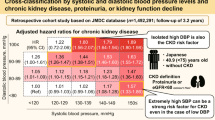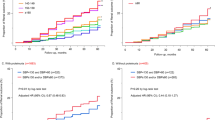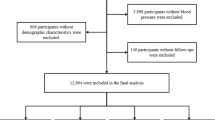Abstract
The aim of this study was to determine whether the blood pressure (BP) classification recommended in the 2017 American College of Cardiology (ACC)/American Heart Association (AHA) hypertension guidelines is useful for the prediction of chronic kidney disease (CKD) in adults. We conducted a retrospective cohort study using annual health check data in Iki City, Nagasaki, Japan. A total of 3269 adults without CKD, who were not on BP-lowering medication, were included in the present analysis. BP was classified as: normal (systolic BP (SBP) <120 mmHg and diastolic BP (DBP) <80 mmHg), elevated BP (120 ≤ SBP < 130 and/or DBP < 80), stage 1 hypertension (130 ≤ SBP < 140 and/or 80 ≤ DBP < 90), and stage 2 hypertension (SBP ≥ 140 mmHg and/or DBP ≥ 90 mmHg). The primary outcome of the study was new-onset CKD. The effects of BP on the development of CKD were evaluated using Cox’s proportional hazards modelling. During a mean follow-up of 4.8 years, 472 (14.4%) participants developed CKD. The incidence (per 1000 person-years) of new-onset CKD was higher in individuals with elevated BP. After adjustment for other risk factors, there were significant associations between elevated BP and new-onset CKD: hazard ratio 1.11 (95% confidence interval 0.87–1.42) in elevated BP, 1.25 (1.01–1.54) in stage 1 hypertension, and 1.45 (1.18–1.79) in stage 2 hypertension, compared with the reference group with normal BP (P < 0.001 for trend). Thus, the findings of this study confirm the definition of hypertension (≥130/80 mmHg) recommended by the 2017 ACC/AHA guidelines for the management of hypertension to be useful for the prediction of new-onset CKD.
This is a preview of subscription content, access via your institution
Access options
Subscribe to this journal
Receive 12 digital issues and online access to articles
$119.00 per year
only $9.92 per issue
Buy this article
- Purchase on Springer Link
- Instant access to full article PDF
Prices may be subject to local taxes which are calculated during checkout



Similar content being viewed by others
References
James PA, Oparil S, Carter BL, Cushman WC, Dennison-Himmelfarb C, Handler J, et al. 2014 Evidence-Based Guideline for the Management of High Blood Pressure in Adults. Jama. 2014;311:507. http://jama.jamanetwork.com/article.aspx?doi=10.1001/jama.2013.284427.
Mancia G, Fagard R, Narkiewicz K, Redon J, Zanchetti A, Böhm M, et al. 2013 ESH/ESC guidelines for the management of arterial hypertension: The Task Force for the management of arterial hypertension of the European Society of Hypertension (ESH) and of the European Society of Cardiology (ESC). Eur Heart J. 2013;34:2159–219.
Pk W, Whelton PK, Carey RM, Aronow WS, Ovbiagele B, Casey DE, et al. 2017 Guideline for the Prevention, Detection, Evaluation, and Management of High Blood Pressure in Adults A Report of the American College of Cardiology / American Heart Association T [Internet]. Journal of American College of Cardiology. 2017. 283 p. http://www.ncbi.nlm.nih.gov/pubmed/29133356.
Muntner P, Carey RM, Gidding S, Jones DW, Taler SJ, Wright JT, et al. Potential U.S. Population Impact of the 2017 American College of Cardiology/American Heart Association High Blood Pressure Guideline. J Am Coll Cardiol. 2017;71. http://linkinghub.elsevier.com/retrieve/pii/S0735109717414744.
Matsuo S, Imai E, Horio M, Yasuda Y, Tomita K, Nitta K, et al. Revised equations for estimated GFR from serum creatinine in Japan. Am J Kidney Dis. 2009;53:982–92. https://doi.org/10.1053/j.ajkd.2008.12.034.
Japanese Society of Nephrology. Evidence-based Practice Guideline for CKD. 2013;154–6.
Group KDIGO (KDIGO) CW. KDIGO 2012 Clinical Practice Guideline for the Evaluation and Management of Chronic Kidney Disease. Kidney Int Suppl. 2013;3:4–4. http://www.kdigo.org/clinical_practice_guidelines/pdf/CKD/KDIGO CKD-MBD GL KI Suppl 113.pdf%5Cn http://www.nature.com/doifinder/10.1038/kisup.2012.73%5Cn http://www.nature.com/doifinder/10.1038/kisup.2012.76.
The Japanese Society of Cardiovascular Disease Prevention. Handbook for cardiovascular prevention. Hokendojinsha; 2014.
Article S. New Criteria for ‘Obesity Disease’ in Japan. Circ J. 2002;66:987–92.
The Japan Diabetes Society. Management of diabetes 2016-2017. Bunkōdō; 2016. 118 p.
Japan Atherosclerosis society. Guidelines for prevention of atherosclerotic cardiovascular disease 2017. Nihon domyakukokagakkai; 2017.
Acid J society of gout and neucleicMetabolism. Guideline for the management of hyperuricemia and gout. Medikarurebyūsha; 2010.
Fox C, Larson M, Leip E, Culleton B, Wilson P, Levy D. Predictors of new onset kidney disease in a community- based population. JAMA. 2004;291:844–50.
Kanno A, Kikuya M, Ohkubo T, Hashimoto T, Satoh M, Hirose T, et al. Pre-hypertension as a significant predictor of chronic kidney disease in a general population: the Ohasama Study. Nephrol Dial Transpl. 2012;27:3218–23.
Tohidi M, Hasheminia M, Mohebi R, Khalili D, Hosseinpanah F, Yazdani B, et al. Incidence of chronic kidney disease and its risk factors, results of over 10 year follow up in an Iranian cohort. PLoS ONE. 2012;7:1–9.
Obermayr RP, Temml C, Knechtelsdorfer M, Gutjahr G, Kletzmayr J, Heiss S, et al. Predictors of new-onset decline in kidney function in a general middle-European population. Nephrol Dial Transpl. 2008;23:1265–73.
Hirayama A, Konta T, Kamei K, Suzuki K, Ichikawa K, Fujimoto S, et al. Blood pressure, proteinuria, and renal function decline: associations in a large community-based population. Am J Hypertens. 2015;28:1150–6.
Yano Y, Fujimoto S, Sato Y, Konta T, Iseki K, Iseki C, et al. New-onset hypertension and risk for chronic kidney disease in the Japanese general population. J Hypertens. 2014;32:2371–7.
Klag MJ, Whelton PK, Randall BL, Neaton JD, Brancati FL, Ford CE, et al. Blood pressure and end-stage renal disease in men. N Engl J Med. 1996;334:13–18. http://www.nejm.org/doi/abs/10.1056/NEJM199601043340103.
Tozawa M, Iseki K, Iseki C, Kinjo K, Ikemiya Y, Takishita S. Blood pressure predicts risk of developing end-stage renal disease in men and women. Hypertension. 2003;41:1341–5.
Acknowledgements
We thank Mark Cleasby, PhD, from Edanz Group (www.edanzediting.com/ac) for editing a draft of this manuscript.
Author information
Authors and Affiliations
Corresponding author
Ethics declarations
Conflict of interest
The authors declare that they have no conflict of interest.
Additional information
Publisher’s note: Springer Nature remains neutral with regard to jurisdictional claims in published maps and institutional affiliations.
Supplementary information
Rights and permissions
About this article
Cite this article
Maeda, T., Yoshimura, C., Takahashi, K. et al. Usefulness of the blood pressure classification in the new 2017 ACC/AHA hypertension guidelines for the prediction of new-onset chronic kidney disease. J Hum Hypertens 33, 873–878 (2019). https://doi.org/10.1038/s41371-019-0198-7
Received:
Revised:
Accepted:
Published:
Issue Date:
DOI: https://doi.org/10.1038/s41371-019-0198-7
This article is cited by
-
Relationship between abdominal circumference and the incidence of hyperuricemia in the general Japanese population
Scientific Reports (2024)
-
Elevation in white blood cell count and development of hyper LDL cholesterolemia
Scientific Reports (2023)
-
Eating before bed and new-onset hypertension in a Japanese population: the Iki city epidemiological study of atherosclerosis and chronic kidney disease
Hypertension Research (2021)
-
Association between pulse pressure and progression of chronic kidney disease
Scientific Reports (2021)
-
Cause, Consequence or confounding? The kidney in hypertension
Journal of Human Hypertension (2019)



